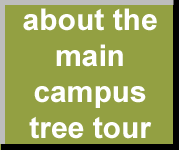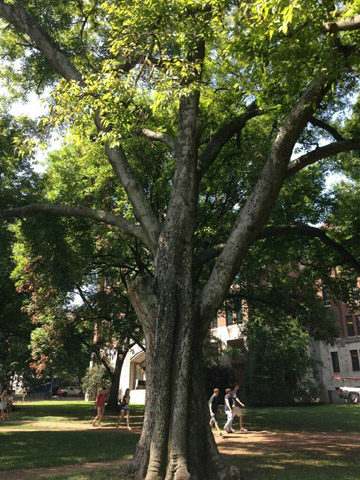 |  |  |  |
 |  |  |  |
An individual instance of Celtis occidentalis (common hackberry)

Permanent unique identifier for this particular organism:
http://bioimages.vanderbilt.edu/vanderbilt/4-216
Notes:
This large tree is near the center of the Bishop's Common on the north side of the sidewalk that crosses the Common diagonally. This is only the third largest hackberry in the arboretum overall, but it is noteworthy in that it has an impressive crown spread of 28 m (91 ft.). Its spread was probably once much larger before it lost one of its major branches.
Hackberry leaves have somewhat uneven leaf bases, a characteristic they share with other members of the elm family. Unlike elms, they have single teeth or no teeth at all. As their name suggests, hackberry fruits are fleshy berries, in contrast to the dry, winged seeds of elms. Perhaps the most noticeable characteristic of hackberries is their bark. Overall, they tend to have smooth bark, similar to beech bark. However, hackberry bark nearly always few to many corky lumps scattered throughout the smooth bark, which is rarely the case with beech.
It is not always possible to assign hackberries to a particular species because they hybridize and can have intermediate characteristics. However, this tree has characteristics typical of Northern hackberry (Celtis occidentalis). Northern hackberry leaves are broader and more toothed than the leaves of southern hackberry (Celtis laevigata). The fruit of northern hackberry is dark red or blackish when mature, in contrast to the more orange-red fruit of southern hackberry. Northern hackberry also has the smooth bark with lumps similar to that of southern hackberry.
It is more typical around Nashville to find hackberries displaying the C. laevigata characteristics because we are near the southern edge of C. occidentalis. But as this tree illustrates, C. occidentalis types can be found in this area.
Hackberry leaves have somewhat uneven leaf bases, a characteristic they share with other members of the elm family. Unlike elms, they have single teeth or no teeth at all. As their name suggests, hackberry fruits are fleshy berries, in contrast to the dry, winged seeds of elms. Perhaps the most noticeable characteristic of hackberries is their bark. Overall, they tend to have smooth bark, similar to beech bark. However, hackberry bark nearly always few to many corky lumps scattered throughout the smooth bark, which is rarely the case with beech.
It is not always possible to assign hackberries to a particular species because they hybridize and can have intermediate characteristics. However, this tree has characteristics typical of Northern hackberry (Celtis occidentalis). Northern hackberry leaves are broader and more toothed than the leaves of southern hackberry (Celtis laevigata). The fruit of northern hackberry is dark red or blackish when mature, in contrast to the more orange-red fruit of southern hackberry. Northern hackberry also has the smooth bark with lumps similar to that of southern hackberry.
It is more typical around Nashville to find hackberries displaying the C. laevigata characteristics because we are near the southern edge of C. occidentalis. But as this tree illustrates, C. occidentalis types can be found in this area.
 |  |
Load database and switch to thumbnail view
Use this stable URL to link to this page:
http://bioimages.vanderbilt.edu/vanderbilt/4-216.htm
This organism is a living specimen that is part of the Vanderbilt University Arboretum with the local identifier 2-253.
This particular organism is believed to have managedmeans of establishment.
This organismal entity has the scope: multicellular organism.
Identifications:
Celtis occidentalis
L.
sec. fna.org 1993
common name: common hackberry
family: Ulmaceae
Identified 2014-09-18 by Steven J. Baskauf
Location:
southeast of Furman Hall, Vanderbilt University, Nashville, Davidson County, Tennessee, US
Click on these geocoordinates to load a map showing the location: 36.14746°, -86.8009°
Coordinate uncertainty about: 10 m.
Altitude: 160 m.
Location of individual determined from GIS database.
Occurrences were recorded for this particular organism on the following dates:
2014-08-20
The following images document this particular organism.
Click on a thumbnail to view the image and its metadata.Load database and enable navigation by taxon and organism.
| Image | View |
 | whole tree (or vine) - general |
 | whole tree (or vine) - view up trunk |
 | whole tree (or vine) - view up trunk |
 | leaf - showing orientation on twig |